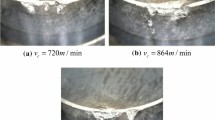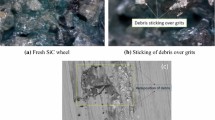Abstract
Al2024 belongs to a typical Al-Cu-Mg series alloy. It has the advantages of high-strength, low-specific gravity, stress resistance, corrosion resistance, good heat resistance, and high fatigue resistance. It is widely used in aerospace, automobiles, ships, chemicals, and other fields. Aluminum alloys play a pivotal role in industry and manufacturing. Cemented carbide tools are often used in the processing of aluminum alloys, and diffusion wear is prone to occur during the processing. It is of great significance to study the diffusion phenomenon of WC tools in the process of cutting aluminum alloys for improving tool life and workpiece surface machining accuracy. In this paper, based on the molecular dynamics (MD) simulation method, the WC tool and the Al2024 model were established, the Morse potential parameters between the tool and the workpiece atoms were calculated, and the diffusion wear mechanism of the WC tool in the process of cutting Al2024 was studied. Through the displacement nephogram in the tool-worker X direction, it is found that the workpiece atoms have a tendency to diffuse to the tool. Using the mean square displacement (MSD) method, the diffusion velocities of Al, Cu, and Mg atoms in the workpiece were obtained. The results show that the activation energy of atomic vacancies at the grain boundary is smaller than that at the lattice, and the Al, Cu, and Mg atoms at the grain boundary of the workpiece are more likely to diffuse, and the diffusion rate of Mg atoms is the fastest. The total energy of single atoms in the cutting process was analyzed, and it was found that the energy required for Al, Cu, and Mg elements at the grain boundary of the workpiece to diffuse into the WC tool and the energy required for the Mg and Al elements at the workpiece lattice to diffuse into the WC tool were satisfied.


















Similar content being viewed by others
References
Ding Y (2013) Research on high temperature rheological law and fracture behavior of 2024 aluminum alloy. Dissertation, Hunan: Central South University
Bing Liu, Chaoqun Peng, Richu Wang, Xiaofeng Wang, Tingting Li (2010) Research status and prospect of aluminum alloy for large aircraft. Chinese J Nonferrous Metals 20(9):1705–1706. https://doi.org/10.19476/j.ysxb.1004.0609.2010.09.008
Wang W (2020) Study on the diffusion mechanism of CBN tool cutting nickel-based alloy tool-worker interface. Dissertation, Changchun University of Technology
Femi E, Pasta J, Ulam SM (1955) Studies of non-linear problems. In: Nonlinear wave motion. Los Alamos National Laboratory, New Mexico, pp 143–156
Alder BJ, Wainwright TE (1959) Studies in molecular dynamics I General method. J Chem Physics 31(2):459–466
Verlet L (1967) Computer" experiments" on classical fluids I Thermodynamical properties of Lennard-Jones molecules. Phys Rev 159(1):79–85
Maekawa K, Itoh A (1995) Friction and tool wear in nano-scale machining—a molecular dynamics approach[J]. Wear 188(1–2):115–122
Fang TH, Weng CI (2000) Three-dimensional molecular dynamics analysis of processing using a pin tool on the atomic scale[J]. Nanotechnology 11(3):148
Jun S, Tanaka H, Lian Zhou, Hiroshi E (2004) Molecular dynamics analysis of ultra high-acceleration and vibration cutting. Key Eng Mater 257–258(21):26. https://doi.org/10.4028/www.scientific.net/KEM.257-258.21
Tang Y, Liang Y, Huo D, Chen K (2004) Comparison of nanometric cutting processes for monocrystalline silicon and aluminum. Harbin Inst Technol 36(1):39–42. https://doi.org/10.3321/j.issn:0367-6234.2004.01.011
Zhang Y (2016) Simulation of nano-vibration cutting of titanium metal based on molecular dynamics. Dissertation, Shenyang University of Aeronautics and Astronautics
Cheng K, Luo X, Ward R, Holt R (2003) Modeling and simulation of the tool wear in nanometric cutting. Wear 255(7):14
Cai MB, Li XP, Rahman M (2007) Study of the mechanism of groove wear of the diamond tool in nanoscale ductile mode cutting of monocrystalline silicon. J Manuf Sci Eng 129(2):281–286. https://doi.org/10.1115/1.2673567
Narulkar R (2009) Investigation on the mechanism of wear of single crystal diamond tool in nanometric cutting of iron using molecular dynamics (MD) and the development of generalized potential energy surfaces (GPES) based on ab initio calculations. Oklahoma State University
Goel S, Luo X, Reuben RL (2012) Molecular dynamics simulation model for the quantitative assessment of tool wear during single point diamond turning of cubic silicon carbide[J]. Comput Mater Sci 51(1):402–408
Han X (2007) Molecular dynamics analysis of atomic scale wear mechanism of tools in nano-cutting process. J Mech Eng 43(9):107–112. https://doi.org/10.3321/j.issn:0577-6686.2007.09.022
Dong G, Wang X, Gao S (2018) Molecular dynamics simulation and experiment research of cutting-tool wear mechanism for cutting aluminum alloy. Int J Adv Manufac Technol 96(1):1123–1137
Zhaopeng Hao, Xue Han, Yihang Fan (2020) Molecular dynamics analysis of tool wear in cutting Ni-Fe-Cr-Co-Cu nickel-based alloys. Mech Eng Technol 9(02):60. https://doi.org/10.12677/MET.2020.92006
Jiajia Luo, Yaping Bai, Jianping Li, Yongchun Guo (2018) Influence of two heat treatment processes on the wear behavior of 2024 aluminum alloy. J Xi’an Univ Technol 38(6):627. https://doi.org/10.16185/j.jxatu.edu.cn.2018.06.014
Lan H (2019) Research on the diffusion mechanism of cemented carbide tool cutting GH4169 tool-chip interface based on molecular dynamics simulation. Dissertation, Changchun University of Technology
Juslin N, Erhart P, Träskelin P, Nord J, Henriksson KOE, Nordlund K, Salonen E, Albe K (2005) Analytical interatomic potential for modeling nonequilibrium processes in the W-C–H system. J Appl Phys 98(12):123520
Zhou XW, Johnson RA, Wadley HNG (2004) Misfit-energy-increasing dislocations in vapor-deposited CoFe/NiFe multilayers[J]. Phys Rev B 69(14):144113
Hao Z, Han X, Fan Y (2019) Research on tool interface behavior of silicon carbide toughened alumina-based ceramic tool cutting Inconel 718 alloy. China Mech Eng 32(9):1009–1016. https://doi.org/10.3969/j.issn.1004-132X.2021.09.001
Lim TC (2004) Relationship and discrepancies among typical interatomic potential functions. Chin Phys Lett 21(11):2167–2170. https://doi.org/10.3321/j.issn:0256-307X.2004.11.025
Roy D, Manna A, Gupta SPS (1972) The application of the Morse potential function in ordered Cu3Au and Au3Cu alloys. J Phys F Met Phys 2:1092–1099. https://doi.org/10.1088/0305-4608/2/6/013
Hatipoğlu HA, Polat N, Koksal A, Tekkaya AE (2007) Modeling flexforming fluid cell forming process with finite element method. Key Eng Mater 67(344–344):469
Mehl MJ, Klein BM (1991) All-electron first-principles supercell total-energy calculation of the vacancy formation energy in aluminium[J]. Physica B 172(1–2):211–215
Hu W, Qi W, Zhang B (1999) A semiempirical method to estimate vacancy formation energy of metals. J Hunan Univ 26:10–14. https://doi.org/10.3321/j.issn:1000-2472.1999.05.003
Mendelev MI, Han S, Son W-j, Ackland GJ, Srolovitz DJ (2007) Simulation of the interaction between Fe impurities and point defects in V. Phys Rev B 76(21):214105. https://doi.org/10.1103/PhysRevB.76.214105
Acknowledgements
This work was financially supported by National Natural Science Foundation of Jilin Province, China (Grant No. 20200201065JC). The authors would also like to thank the anonymous reviewers for their helpful comments.
Funding
This work was financially supported by National Natural Science Foundation of Jilin Province, China (Grant No. 20200201065JC).
Author information
Authors and Affiliations
Contributions
Xueguang Li guided the overall design and analysis of the study, Wang Zhang conducted simulation analysis and wrote the manuscript, and Liqin Miao helped collect data and simulate. The final manuscript was read and approved by all authors.
Corresponding author
Ethics declarations
Consent to participate
All authors declare that they have agreed for authorship, have read and approved the manuscript, and have given the consent for submission and subsequent publication of the manuscript.
Consent for publication
All authors consent to publish this article with its included data in the International Journal of Advanced Manufacturing Technology and approve its final version.
Conflict of interest
The authors declare no competing interests.
Additional information
Publisher's note
Springer Nature remains neutral with regard to jurisdictional claims in published maps and institutional affiliations.
Rights and permissions
Springer Nature or its licensor (e.g. a society or other partner) holds exclusive rights to this article under a publishing agreement with the author(s) or other rightsholder(s); author self-archiving of the accepted manuscript version of this article is solely governed by the terms of such publishing agreement and applicable law.
About this article
Cite this article
Li, X., Zhang, W. & Miao, L. Research on diffusion wear mechanism of WC tool cutting Al2024 based on MD. Int J Adv Manuf Technol 125, 5345–5358 (2023). https://doi.org/10.1007/s00170-023-11024-w
Received:
Accepted:
Published:
Issue Date:
DOI: https://doi.org/10.1007/s00170-023-11024-w




